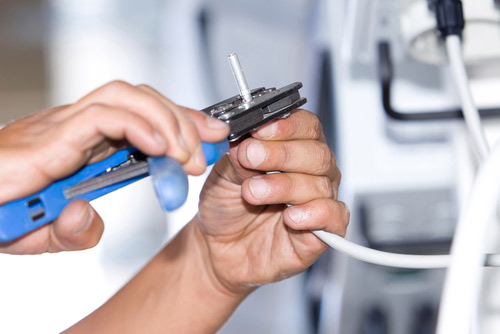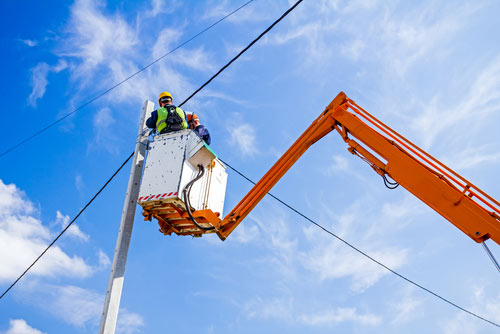
Electrical Safety & Business: It Pays to Go Above and Beyond
Your employees follow the National Electrical Code (NEC) and OSHA rules when setting up electrical power systems at worksites.
While these industry rules have been designed to keep workers and consumers safe, it’s important to find out why they were created and whether they’re the only guidelines you should use in your business.
In this article, we’ll look into the genesis of these regulations and their reasons for being. We’ll also review other benchmarks you can leverage to go beyond the basic NEC and OSHA rules to enhance the level of electrical safety you provide to your workers and to improve the quality of the work your business does.
National Electric Code
The NEC, also referred to as NFPA 70, is the standard for the safe installation of electrical wiring and equipment throughout the United States. It’s part of the National Fire Code and is sponsored and published by the National Fire Protection Association (NFPA).

The NFPA is a private organization, so its recommendations aren’t federal law. Instead, the NEC is adopted (and often adapted) by states and municipalities to standardize legal enforcement of safe electrical practices on a local basis.
The NFPA’s Committee on the National Electrical Code puts together the NEC. The committee is made up of 20 panels and a group that coordinates their work. The NEC is formally approved by the American National Standards Institute (ANSI). ANSI is a non-profit organization that oversees the development of voluntary standards for products, services, processes, systems, and personnel throughout the U.S.
The code dates all the way back to 1897, when the electrical power industry was in its infancy. The standards are revised every three years. (The 2014 edition was the last one published, and a new one is due next year.) States leverage the most recent version within a few years of release.
The recommendations in the national code are generally thought of as minimum standards by local governments. Depending on the state or municipality, the NEC is often added to, changed, or even replaced by more demanding regionalized regulations decided on by local governing agencies.
Why are NEC standards necessary?
In the United States, anyone, including contractors and municipal governments, could face civil lawsuits if they do or contribute to anything that results in injury or loss of life or property because of how electrical systems are installed. Since there is no other guidance about negligence in these issues, the NEC guidelines and adaptations to them made by local governments have become the minimum standards and requirements for the industry.
Looking for electrical components and equipment that meet NEC guidelines? An experienced supplier can provide the information you need to find compliant solutions.
Electricians spend years studying the NEC and practicing them in their work as apprentices before they earn their licenses to do electrical work. Those who fail to use the best practices outlined by the NEC could, and likely will, be found guilty of negligence should anyone become injured or if property is damaged because of a faulty electrical installation.
Food for thought: No court has ever found fault with a firm or individual that followed them to the letter on a job site.
The bottom line: Is simply not being sued, or found guilty in a lawsuit, the ultimate standard you want to use to manage your business?

The Occupational Safety and Health Administration (OSHA) is run by the United States Department of Labor. It was created by Congress in 1970. The agency’s mission is to “assure safe and healthful working conditions for working men and women by setting and enforcing standards and by providing training, outreach, education, and assistance.”

In order to achieve its mission, OSHA provides rules, training, compliance help, and health and safety programs, including many specific to people who work with electricity.
OSHA covers most private sector employers and their workers, which includes electrical contractors, mining companies, firms that handle lighting and sound at concert venues, and others who work with electricity and electrical components and equipment. Workers in all 50 states and most U.S. territories are included. Some states run OSHA programs that are stricter than the federal one.
Want to make sure your temporary power setup is OSHA compliant? A supplier experienced in working with contractors, mines, concert venues, and other industries can provide the advice you need.
By law, employers must provide a workplace that doesn’t present significant health and safety hazards and follows all OSHA guidelines. They’re required to identify and fix any hazards. In addition, it’s a priority to eliminate or reduce workplace issues by altering working conditions rather than simply taking protective measures. According to OSHA, risk reduction or elimination is more important than risk avoidance.
Under OSHA, a few of the things employers are required to do for workers include:
- Informing them about potential workplace hazards.
- Providing easy-to-understand safety training.
- Keeping complete records of workplace injuries and health issues.
- Performing required work site safety monitoring and tests.
- Providing no-cost personal protective clothing, gear, and equipment.
- Providing required medical tests.
- Visibly posting OSHA notifications and information.
- Never penalizing anyone who takes advantage of their rights under OSHA or who communicates with OSHA about workplace issues.
Under OSHA regulations, some of the things workers on a job site have a right to include:
- Working in conditions that don’t expose them to significant risks.
- Being able to file complaints with OSHA that are completely confidential.
- Access to easy-to-understand information and training about workplace safety issues, how to avoid them, and the OSHA regulations that apply to the work they do.
- Getting copies of records of on-the-job injuries and health issues that happen in their workplace.
- Seeing the results of tests and monitoring related to potential workplace hazards.
- Taking part in OSHA workplace inspections.
- Being able to speak privately with OSHA inspectors.
- Filing a complaint if they have been punished by their employer because they contacted OSHA.
OSHA standards are strict, but they’re not all you can do to protect your workers.
Enhancements to NEC and OSHA standards

Here are a few things you can do to move beyond NEC and OSHA guidelines to create a more secure work environment and improve the level of service you provide to clients.
1. Talk to your insurance provider. You have insurance to cover your company and its business practices. Ideally, it’s provided by a firm that specializes in offering protection for businesses in your industry. If that’s the case, many of the larger, better-known providers will welcome the opportunity to visit your worksites and conduct safety reviews.
Experienced insurance inspectors know what types of hazards and accidents are common in your industry and can offer insights on how to avoid them. Incorporating the advice you receive from your insurance provider into your everyday business practices could lead to a significant reduction in insurance premiums.
2. Leverage the National Electrical Installation Standards (NEIS). These guidelines go well beyond offering businesses guidance on avoiding safety issues and lawsuits. They provide advice on how to do solid electrical workmanship. Similar to the NEC, they’re approved by the American National Standards Institute (ANSI).
The NEIS are used by workers to learn how to do higher quality electrical work. Electrical professionals frequently see references to “good workmanship” in plans and specs. The NEIS actually defines what this is in clear, understandable, and actionable terms.
Interesting fact: The NEIS are referenced in the NEC.
3. Stay current. It takes time for government agencies (like OSHA) and private groups (like the NFPA) to research and report on electrical innovations and new best practices. It can take anywhere from three years to a decade for new electrical safety guidelines to be researched, approved, published, distributed, and implemented by the industry.
That’s why it’s important for you to read industry publications, take classes, and attend industry events to ensure you’re leveraging the latest innovations in your business.
4. Talk with experts. Electrical equipment supply businesses help clients solve problems all the time. They’re aware of all the latest electrical supplies and equipment and how to use these things effectively. The experts who work for quality suppliers are a great source of information on how you can move beyond industry standards and guidelines to run your operation at optimal levels.
What are you waiting for? Start taking steps towards making your work sites the safest they can be and taking your business practices to the next level.

 CALL OR TEXT NOW 800-597-9311
CALL OR TEXT NOW 800-597-9311
Leave a comment